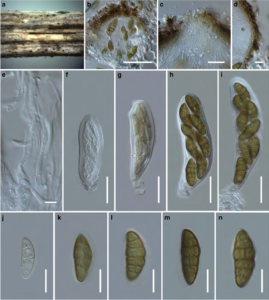Allophaeosphaeria clematidis Wanasinghe, Camporesi, E.B.G. Jones & K.D. Hyde.
Index Fungorum number: IF551408; Facesoffungi number: FoF00947; Fig. 1
Etymology – Name reflects the host genus Clematis, from which the species was collected.
Holotype – MFLU 15-1505
Saprobic on dead branches of Clematis vitalba L. Sexual morph: Ascomata 110 – 130 μm high, 150 – 180 μm diam. (x̄ = 124.1 × 166 μm, n = 10), superficial, solitary, scattered, broadly oblong and flattened, dark brown to black, coriaceous, ostiolate. Ostiole 25 – 35 μm high, 25 – 40 μm diam. (x̄ = 29.5 × 32.7 μm, n = 5), papillate, black, smooth, comprising short, hyaline setae. Peridium 4 – 6 μm wide at the base, 9 – 10 μm wide in sides, comprising 3 – 4 layers, of heavily pigmented, thin-walled, blackish to dark brown, cells of textura angularis. Hamathecium comprising numerous, 2 – 2.5 μm (n = 30) wide, filamentous, branched, septate, pseudoparaphyses. Asci 60 – 100 × 15 – 30 μm (x̄ = 79.7 × 20.3 μm, n = 40), 8 – spored, bitunicate , fissitunicate, cylindric – clavate, short pedicellate, rounded and thick – walled at the apex, with an ocular chamber. Ascospores 20 – 25 × 8 – 10 μm (x̄ = 23.2 × 9.1 μm, n = 50), overlapping 1 – 2 – seriate, initially hyaline, becoming brown at maturity, mostly ellipsoidal, curved, muriform with 4 – 6 transverse septa, and 3 – 4 vertical septa, strongly constricted at the central septa, the cells above the central septum wider, weakly constricted at the other septa, with conical, narrowly rounded ends, lacking a mucilaginous sheath. Asexual morph: Undetermined.
Culture characteristics – Colonies on PDA reaching 30 – 35 mm diam. in 21 days, surface dirty white, spreading with moderate aerial mycelium, and smooth even, margins; reverse pale luteous.
Material examined – ITALY, Forlì-Cesena Province,Fiumicello in Premilcuore, dead and hanging branches of Clematis vitalba (Ranunculaceae), 5 December 2013, E. Camporesi (MFLU 15-1505, holotype), ex-type living culture, MFLUCC 14-0652.
Notes – Allophaeosphaeria clematidis differs from A. dactylidis in having 23.2 × 9.1 μm, mostly ellipsoidal, curved ascospores, with 4 – 6 transverse septa, and 3 – 4 vertical septa, while A. dactylidis has 18.2 × 6.3 μm, ellipsoidal to subfusiform, ascospores with 3 – 5 transverse septa, and 1 – 3 vertical septa. Allophaeosphaeria muriformia differs from A. clematidis in having large, oblong to narrowly oblong, 56 × 26 μm ascospores.

Fig. 1 Allophaeosphaeria clematidis (holotype). a Appearance of ascomata on host substrate. b Section of ascoma c Close up of ostiole d Peridium e Pseudoparaphyses f – i Asci j – n Ascospores. Scale bars: b = 50 μm, c = 20 μm, d = 10 μm, e = 5 μm, f – i = 20 μm, j – n = 10 μm.
